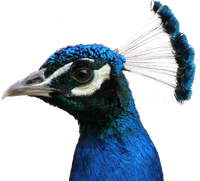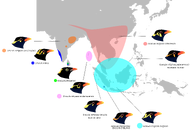| Eastern Osprey | |
|---|---|
| File:Eastern Ospry.png | |
| Adult Eastern Osprey | |
NE
| |
| Scientific classification | |
| Kingdom: | Animalia |
| Phylum: | Chordata |
| Class: | Aves |
| Clade: | Inopinaves |
| Clade: | Afroaves |
| Superorder: | Accipitrimorphae |
| Order: | Accipitriformes |
| Family: | Pandionidae |
| Genus: | Pandion |
| Species: | P. haliaetus |
| Subspecies: | P. h. cristatus |
| Trinomial name | |
| Pandion haliaetus cristatus Vieillot, 1816 | |
| File:Wiki-Pandion haliaetus.png | |
| Synonyms | |
|
Pandion cristatus (Linnaeus, 1758) | |
Other names[]
White-headed Osprey, Fish Hawk.[1]
Taxonomy[]
The taxonomy of the Eastern Osprey is controversial. The most widely accepted contemporary taxonomic arrangement recognises a single species, Pandion haliaetus, with four subspecies: nominate subspecies haliaetus in the Palearctic, carolinensis in North America, ridgwayi in the Caribbean and cristatus (or leucocephalus) in Australasia and New Caledonia (Ferguson-Lees & Christie 2001[2]; Poole 1994[3]; Prevost 1983[4]; Sibley & Monroe 1990[5].) [1].
However, Wink and colleagues (2004)[6] and Wink and Sauer-Gürth (2004)[7] studied three of the four subspecies (haliaetus, carolinensis and cristatus) and proposed that each be elevated to full species status based on differences in distribution, morphology and genetics between the three taxa.
This treatment was accepted by Christidis and Boles (2008)[8] but has not been adopted by BirdLife International (2007k)[9] or Remsen and colleagues (2008). This profile follows Christidis and Boles (2008) and Dickinson (2003)[10] in elevating subspecies cristatus to full species status as the Eastern Osprey, Pandion cristatus. [1]
Description[]
Similar species[]
Behaviour[]
The Osprey is known for it's migratory flights to Africa during the autumn, they leave towards the end of August/September and don't return until the spring, juveniles though will remain in Africa for a few years until they are old enough to reproduce.
Diet[]
The Osprey is a bird that lives mainly off fish. In fact around 99% of it's diet consists of fish which it eats head-first. The remaining 1% is made up of careless amphibians, birds (usually juv.) and small mammals, but these are only taken in unusual circumstances.
Calls[]
Reproduction[]
Osprey's aren't birds to mate for life, as they migrate the male usually arrives back at the nesting site first and if a female osprey arrives which he hasn't mated with before previously he will mate with her anyway due to the fact that there is a morality rate for osprey's especially due to the fact that the flight to South Africa is a dangerous one.
Distribution/habitat[]
References[]
- ^ a b c Department of Sustainability, Environment, Water, Population and Communities (2011). Pandion cristatus in Species Profile and Threats Database, Department of Sustainability, Environment, Water, Population and Communities, Canberra. Available from: http://www.environment.gov.au/sprat. Accessed Wed, 10 Aug 2011 05:11:42 +1000.
- ^ Ferguson-Lees, J. & D.A. Christie (2001). Raptors of the World. London: Christopher Helm.
- ^ Poole, A.F. (1994). Family Pandionidae (Osprey). In: del Hoyo, J., A. Elliott, & J. Sargatal, eds. Handbook of the Birds of the World. Page(s) 42-51. Barcelona: Lynx Edicions.
- ^ Prevost, Y. (1983). Osprey distribution and subspecies taxonomy. In: Seymour, D.M, N.R. Seymour, R. Norman, & J.M. Gerrard, eds. Biology and Management of Bald Eagles and Ospreys. Page(s) 157-174.
- ^ Sibley, C.G. & B.L. Monroe (1990). Distribution and Taxonomy of the Birds of the World. New Haven, Connecticut: Yale University Press.
- ^ Wink M., H. Sauer-Gürth, & H-H. Witt (2004). Phylogenetic differentiation of the Osprey Pandion haliaetus inferred from nucleotide sequences of the mitochondrial cytochrome b gene. In: Chancellor, R.D., & B-U. Meyberg, eds. Raptors Worldwide. Page(s) 511-516. Budapest, WWGBP/MME.
- ^ Wink, M., & H. Sauer-Gürth (2004). Phylogenetic relationships in diurnal raptors based on nucleotide sequences of mitochondrial and nuclear gene markers. Chancellor, R.D., & B-U. Meyberg, eds. Raptors Worldwide. Page(s) 483-498. Budapest, WWGBP/MME.
- ^ Christidis, L. & W.E. Boles (2008). Systematics and Taxonomy of Australian Birds. Collingwood, Victoria: CSIRO Publishing.
- ^ BirdLife International (2007k). Species factsheet: Pandion haliaetus. Viewed on 16 May 2008. [Online]. Available from: http://www.birdlife.org/datazone/speciesfactsheet.php?id=32559.
- ^ Dickinson, E.C., ed. (2003). The Howard and Moore Complete Checklist of the Birds of the World. Page(s) 1039. London: Christopher Helm.
External links[]
| Projects | ||||||||
|---|---|---|---|---|---|---|---|---|
| ||||||||


